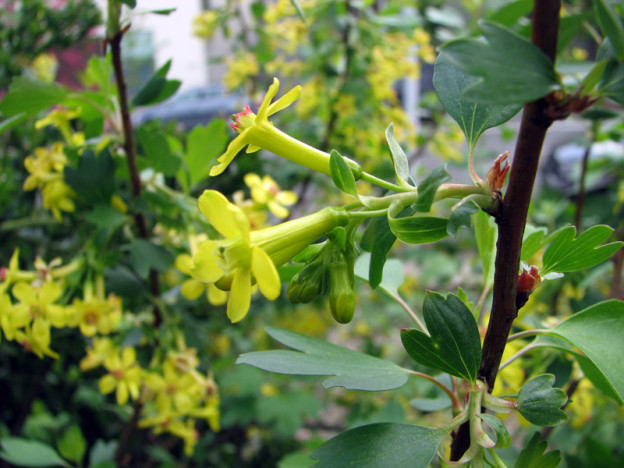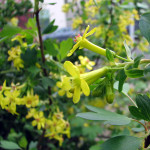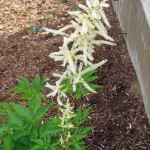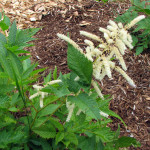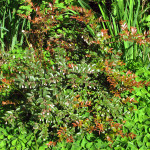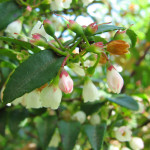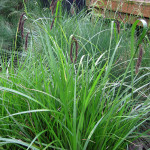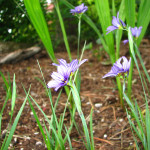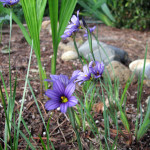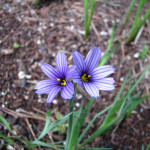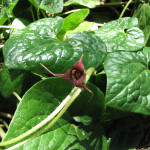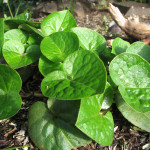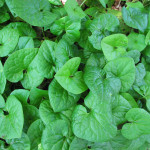Ribes aureum
Golden currant (Ribes aureum) is a small to medium-sized deciduous shrub named for its golden flowers and golden red fall foliage. It is common in Oregon and Washington east of the Cascades and into the Great Basin.
Golden currant grows in full sun and partial shade, in dry to moist conditions, and is drought tolerant. The leaves are deciduous, lobed, and vaguely maple-like, ½ – 1½ inches. Charming clusters of yellow flowers bloom from mid- to late-spring. Golden currant grows to approximately 6 feet tall by 6 feet wide.
It attracts hummingbirds and butterflies such as the spring azure and mourning cloak, and the fruit is eaten by birds and other wildlife. Combine this in a sunny spot with its cousin, red-flowering currant, and drought-tolerant groundcovers like alliums and camas, for a beautiful native display!
- Light Requirements: Full Sun, Part Shade
- Water Requirements: Dry, Moist
- Ease of Growing:
- Growth Rate: Moderate
- Spreads: No
- Wildlife Support: Hummingbirds, Birds or Mammals
- Fire-resistant: No
- Edible: Yes
- Mature Height: 6ft
- Mature Width:6ft
Goat’s Beard

Aruncus dioicus
Goat’s Beard has decorative finely-cut foliage and will create a bold, showy effect for a moist or partly-shaded spot all season. Dense, feathery plumes of tight white flowers rise well above the foliage spring to summer.
Goat’s Beard is an excellent background plant or grouped in a woodland setting. It dies back to the ground in winter, only to return gloriously in the spring. Goat’s Beard spreads slowly by rhizomes to form attractive patches, and can be planted in more sunny areas provided there is good moisture. It’s a “host” plant to the Dusky Azure Butterfly.
- Light Requirements: Part Shade, Full Shade
- Water Requirements: Moist, Perennially Wet
- Ease of Growing: Easy to grow
- Growth Rate: Fast
- Spreads: Yes
- Wildlife Support: Pest-eating Insects, Birds or Mammals, Pollinators
- Fire-resistant: No
- Edible: No
- Mature Height: 5-15ft
- Mature Width:3-5ft
Evergreen Huckleberry
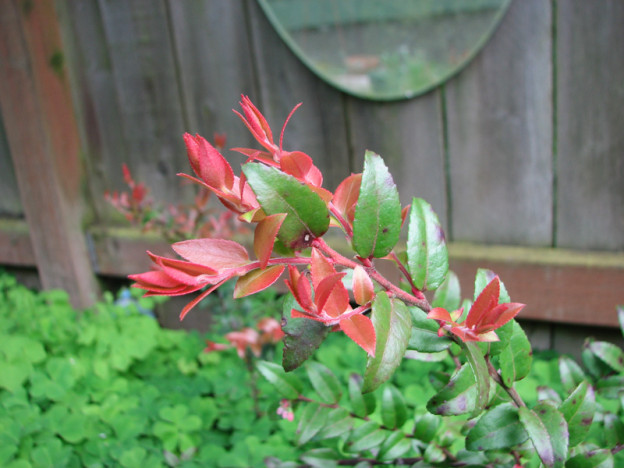
Vaccinium ovatum
Evergreen Huckleberry is a small to medium sized evergreen shrub native to the Pacific Northwest regions of the United States and British Columbia. In the Willamette Valley, it prefers full to partial shade, but will tolerate full sun in coastal areas. It grows slowly and prefers acidic soils.
The shiny, alternately arranged leaves are 2-3.0cm long and 1-1.5cm wide with finely serrated edges. In mid-summer, the plant produces round, edible black berries about 0.5 – 1.0cm in diameter. The berries are a valuable traditional food for many Native American cultures in the Pacific Northwest.
- Light Requirements: Full Sun, Part Shade, Full Shade
- Water Requirements: Moist
- Ease of Growing: Easy to grow
- Growth Rate: Slow
- Spreads: Yes
- Wildlife Support: Pollinators, Hummingbirds, Birds or Mammals
- Fire-resistant: Yes
- Edible: Yes
- Mature Height: 4-8ft
- Mature Width:3-6ft
Slough Sedge

Carex Obnupta
Slough sedge is native to western North America from British Columbia to California where it grows in wetland habitats. The plant produces upright, angled stems approaching 1.2 meters in maximum height, growing in beds or colonies from rhizome networks. The inflorescence is a cluster of flower spikes accompanied by a long leaflike bract.
Wildlife
The lens-shaped seeds are eaten by many kinds of wildlife. Birds known to eat sedge seeds include coots, ducks, marsh birds, shorebirds, upland game birds, and songbirds. In addition to providing food for many wildlife species, sedges are also valuable for cover. Frequently they provide nesting cover for ducks, and their tufted growth furnishes concealment and bedding for other animals. Beavers, otters, muskrats and minks make their way through the sedges as they go to and from the water.
Ethnobotanic
The leaves of slough sedge are used for both wrapping and twining in the grass baskets that are well known and widely marketed by Nitinaht and Nootka women even today.
The Nitinaht believed that picking grasses such as slough sedge for baskets and mats causes fog. The fisherman were always getting annoyed with the women who harvested these materials, because they were always making it foggy. It is said that Hesaquiat men shaved with this grass because the edges are so sharp. There is a saying in Hesaquiat which translates as “you’re just like citapt (slough sedge)” – you never change, because slough sedge is always the same and never seems to change in appearance.
Erosion Control
Slough sedge provides erosion control and streambank stabilization. The dense swards of slough sedge provide sediment retention and nutrient uptake, thus contributing to water quality improvement. Emergent wetland plant communities dominated by slough sedge provide the following hydrologic functions: maintaining river or stream meander patterns; providing a broad, shallow plain where streams slow and sediment deposition occurs; stormwater abatement; a mixing zone where brackish and freshwaters meet; and nutrient-rich habitat for aquatic organisms, fish, waterfowl, and predators such as otter, bald eagles, herons, and raccoons to feed.
- Light Requirements: Full Sun, Part sun
- Water Requirements: Perennially Wet
- Ease of Growing: Easy to grow
- Growth Rate: Moderate
- Spreads:
- Wildlife Support: Birds or Mammals
- Fire-resistant: No
- Edible: No
- Mature Height: 2ft
- Mature Width:1ft
Blue-eyed Grass
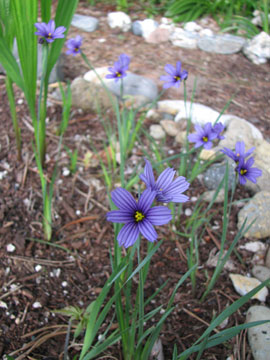
Sisyrinchium idahoense
This plant is not a true grass but has a grass-like appearance as it is low-growing with long, thin leaves. They often grow on grasslands and resemble iris, a close relative. The flower is a deep bluish-purple to blue-violet and rarely white. The fruit is a dry dark or pale-brown capsule with one to several seeds in a locule. It blooms from March to May and is quite variable.
- Light Requirements: Full Sun, Part Shade
- Water Requirements: Moist, Seasonally Wet
- Ease of Growing: Easy to grow
- Growth Rate: Fast
- Spreads: Yes
- Wildlife Support: Pest-eating Insects
- Fire-resistant: Yes
- Edible:
- Mature Height: 8-12in
- Mature Width:6-12in
Larkspur

Delphinium trollifolium
This wildflower reaches one half to just over one meter in height. It has large, shiny, deeply lobed leaves. The top half of the stem is an inflorescence of widely spaced flowers on long pedicels, the longest over nine centimeters long. The flowers are usually deep brilliant blue. The upper two petals may be milky white. The spur exceeds two centimeters in length in the largest of the flowers. This plant is toxic.
- Light Requirements: Part Shade, Full Shade
- Water Requirements: Moist, Seasonally Wet
- Ease of Growing: Easy to grow
- Growth Rate: Moderate
- Spreads:
- Wildlife Support: Pollinators, Hummingbirds
- Fire-resistant: No
- Edible: No
- Mature Height: 4ft
- Mature Width:2ft
Wild Ginger
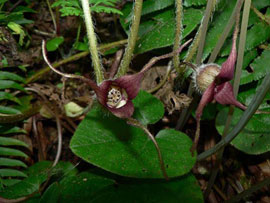
Asarum caudatum
Groundcover with unique maroon flowers hidden under heart-shaped glossy leaves in spring; it has edible roots.
- Light Requirements: Part Shade, Full Shade
- Water Requirements: Moist
- Ease of Growing: Moderate, Difficult
- Growth Rate: Moderate
- Spreads: Yes
- Wildlife Support: Pest-eating Insects, Birds or Mammals
- Fire-resistant: No
- Edible: Yes
- Mature Height: 6in
- Mature Width:3ft
Pacific Crabapple

Malus fusca
Pacific crabapple (Malus fusca) is found in Western Oregon and north through Washington State into Canada and Alaska. It prefers moist woods and is often found at the edges of wetlands. It’s the perfect tree for a wet corner of the garden.
In spring, crabapples bloom with fragrant clusters of pinkish-white blossoms. By mid-summer, 3/4″ long fruits appear. The crabapples turn yellow to reddish in the fall, and often hang on the tree all winter, providing both visual interest and food for wildlife. The leaves of this showy tree also turn orange and bright red in autumn, binging lovely fall color to any garden.
The flowers attract large numbers of native bees including mason bees and bumblebees, and butterflies lay their eggs on the leaves. The fruits are a favorite of birds and small mammals, and the dense foliage provides both food and cover for wildlife.
Pacific crabapple grows best in full sun and moist to wet soils. Plant it with other wet-loving natives such as serviceberry, red osier dogwood, and Pacific ninebark for year-round color and wildlife habitat!
- Light Requirements: Full Sun, Part Shade
- Water Requirements: Moist, Seasonally Wet
- Ease of Growing: Moderate
- Growth Rate: Moderate
- Spreads: No
- Wildlife Support: Pollinators, Hummingbirds, Pest-eating Insects, Birds or Mammals
- Fire-resistant: Yes
- Edible: Yes
- Mature Height: 30ft
- Mature Width:25ft

